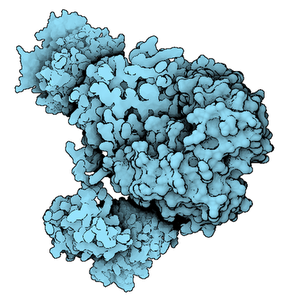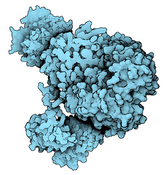Information
- Publication Type: Poster
- Workgroup(s)/Project(s):
- Date: October 2013
- Publisher: BioVis website (http://www.biovis.net/year/2013/posters)
- Location: Atlanta, GA
- Event: 3rd IEEE Symposium on Biological Data Visualization
- Conference date: 13. October 2013 – 14. October 2013
Abstract
We present a novel rendering method, based on the level-of-detail concept, which shows protein complexes over time in real-time. We exploit three different molecular surface models, solvent excluded surface (SES), Gaussian kernels and van der Waals spheres combined in one seamless visualization. As a general rule, closest to the viewer we aim at providing a maximum of relevant information related to the structure and binding sites. Such information is conveyed by the SES representation. Farther away from the viewer, we are smoothly changing the visual representation to an approximation of SES through Gaussian kernels. The least detailed representation is based on simple sphere splatting and is dedicated to structures farthest away from the viewer. A more general solution leads us to the definition of a 3D importance function that is based on the distance measure from a molecular feature. In order to preserve smoothness in transition areas, we introduce three shading levels that correspond to their geometric counterparts and a method for creating seamless transition between these representations. The SES representation with full shading and added contours stands in focus while on the other side a sphere representation with constant shading and without contours provide the context. Moreover, we introduce a methodology to render the entire molecule directly using the A-buffer technique, which further improves the performance. The rendering performance is evaluated on series of molecules of varying atom counts.Additional Files and Images
Weblinks
No further information available.BibTeX
@misc{Viola_2013_IDV,
title = "Importance Driven Visualization of Molecular Surfaces",
author = "Julius Parulek and Timo Ropinski and Ivan Viola",
year = "2013",
abstract = "We present a novel rendering method, based on the
level-of-detail concept, which shows protein complexes over
time in real-time. We exploit three different molecular
surface models, solvent excluded surface (SES), Gaussian
kernels and van der Waals spheres combined in one seamless
visualization. As a general rule, closest to the viewer we
aim at providing a maximum of relevant information related
to the structure and binding sites. Such information is
conveyed by the SES representation. Farther away from the
viewer, we are smoothly changing the visual representation
to an approximation of SES through Gaussian kernels. The
least detailed representation is based on simple sphere
splatting and is dedicated to structures farthest away from
the viewer. A more general solution leads us to the
definition of a 3D importance function that is based on the
distance measure from a molecular feature. In order to
preserve smoothness in transition areas, we introduce three
shading levels that correspond to their geometric
counterparts and a method for creating seamless transition
between these representations. The SES representation with
full shading and added contours stands in focus while on the
other side a sphere representation with constant shading and
without contours provide the context. Moreover, we introduce
a methodology to render the entire molecule directly using
the A-buffer technique, which further improves the
performance. The rendering performance is evaluated on
series of molecules of varying atom counts.",
month = oct,
publisher = "BioVis website (http://www.biovis.net/year/2013/posters)",
location = "Atlanta, GA",
event = "3rd IEEE Symposium on Biological Data Visualization",
Conference date = "Poster presented at 3rd IEEE Symposium on Biological Data
Visualization (2013-10-13--2013-10-14)",
URL = "https://www.cg.tuwien.ac.at/research/publications/2013/Viola_2013_IDV/",
}


 Poster
Poster
